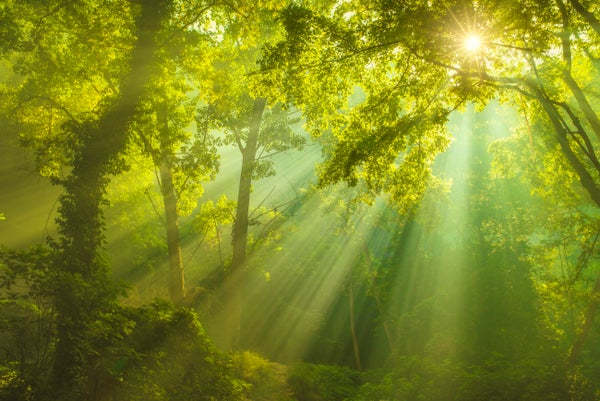This article was published in Scientific American’s former blog network and reflects the views of the author, not necessarily those of Scientific American
Forests are money in the bank. They purify our water and clean our air. They anchor our soils. They cool us and harbor the most diverse ecosystems on earth. When we protect and restore them, we gain a legion of benefits.
Forests are also a global carbon reserve. Vegetation around the world contains almost as much carbon as the entire atmosphere does. Cut trees down, and levels of carbon dioxide rise. Because of deforestation and fossil-fuel burning, concentrations of the greenhouse gas are already almost 50 percent higher than they were just a few centuries ago.
Although excessive CO2 often harms forests by warming the planet, making droughts more severe and insect pests more abundant, CO2 in the air is also food for plants. Extra carbon on a plant’s plate will usually increase photosynthesis and biomass—but only to a point. The more carbon dioxide concentrations rise, the less additional benefit trees may receive unless they can find additional nitrogen and phosphorus to balance their diet.
On supporting science journalism
If you're enjoying this article, consider supporting our award-winning journalism by subscribing. By purchasing a subscription you are helping to ensure the future of impactful stories about the discoveries and ideas shaping our world today.
How much extra carbon dioxide trees will take up this century is a critical uncertainty in predicting global warming. Will trees keep absorbing a quarter or so of fossil-fuel emissions, as they do today? If they don’t, CO2 concentrations in our air will rise even faster for the same level of emissions.
We have just published a paper in Nature Climate Changethat helps answer this question. In our study, we analyzed data from more than 100 large-scale field experiments around the world where scientists grew plants in a high-CO2 environment. The experiments don’t simulate the effects of climate change. Instead they test how plants respond to additional CO2 in the air as a plant food—the building block for photosynthesis.
We found that carbon dioxide levels expected by the end of the century should increase plant biomass globally by about one eighth—12 percent or so. The extra 120 billion metric tons of wood are more than is found in all U.S. forests today. Much of the extra growth will be in the tropical hotspots of the Amazon River basin, the Congo basin and Indonesia. We’ll only reap this global benefit, however, if we protect our forests from misuse.
The amount of biomass we found is substantial, but it’s not as high as you might expect or as some other studies have suggested. The reason is largely because of nutrient limitations. If plants can’t take up additional nitrogen and phosphorus through their roots to balance their diet, they aren’t able to use as much of the extra CO2.
Based on our analysis, soil nitrogen limits potential growth responses to CO2 across about two thirds of ecosystems, and phosphorus restricts growth in about a quarter of them. In many locations, both nitrogen and phosphorus limit plant growth. And we found that the kinds of microbes trees partner with in their roots, especially soil fungi, matter as well. Some fungi, called mycorrhizae, barter with plants, swapping phosphorus and nitrogen they scavenge from the soil for some of the carbon those plants have fixed through photosynthesis. This global swap meet helps plants reduce nutrient limitations somewhat, but it’s not always enough to enable them to use extra carbon dioxide unless people add fertilizers where they grow.
One thing forests can’t do is provide a primary solution to global warming. There aren’t enough forests, and there isn’t enough land, to soak up most of the 40 billion metric tons of carbon dioxide we’re polluting the air with each year. We need to boost another kind of green—green energy—to kill climate change by switching our power plants, cars and homes to low- and no-carbon fuels. That’s money in the bank, too.
